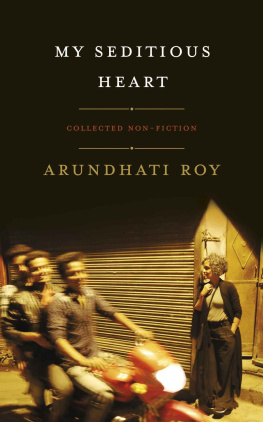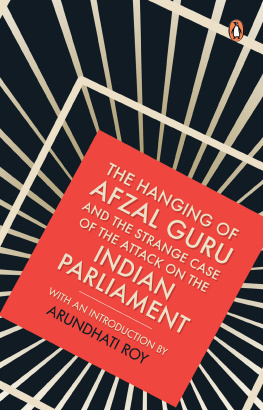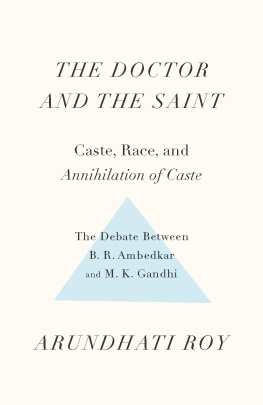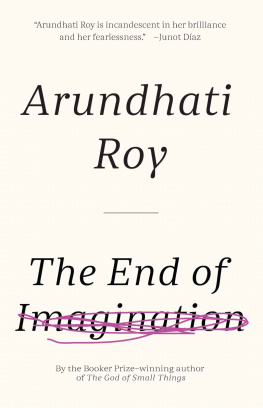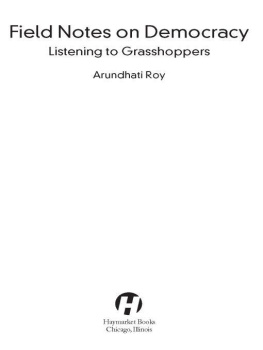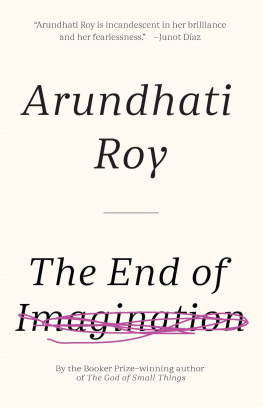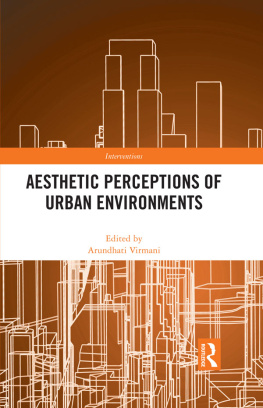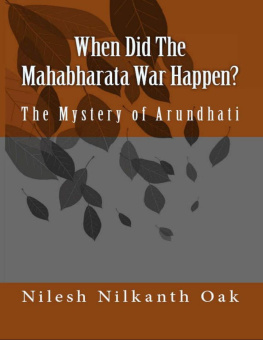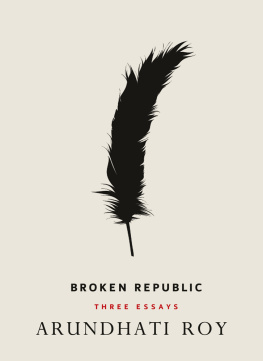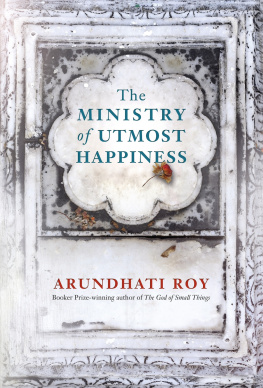Arundhati Roy - My Seditious Heart
Here you can read online Arundhati Roy - My Seditious Heart full text of the book (entire story) in english for free. Download pdf and epub, get meaning, cover and reviews about this ebook. year: 2019, publisher: Haymarket Books, genre: Politics. Description of the work, (preface) as well as reviews are available. Best literature library LitArk.com created for fans of good reading and offers a wide selection of genres:
Romance novel
Science fiction
Adventure
Detective
Science
History
Home and family
Prose
Art
Politics
Computer
Non-fiction
Religion
Business
Children
Humor
Choose a favorite category and find really read worthwhile books. Enjoy immersion in the world of imagination, feel the emotions of the characters or learn something new for yourself, make an fascinating discovery.
- Book:My Seditious Heart
- Author:
- Publisher:Haymarket Books
- Genre:
- Year:2019
- Rating:4 / 5
- Favourites:Add to favourites
- Your mark:
- 80
- 1
- 2
- 3
- 4
- 5
My Seditious Heart: summary, description and annotation
We offer to read an annotation, description, summary or preface (depends on what the author of the book "My Seditious Heart" wrote himself). If you haven't found the necessary information about the book — write in the comments, we will try to find it.
My Seditious Heart — read online for free the complete book (whole text) full work
Below is the text of the book, divided by pages. System saving the place of the last page read, allows you to conveniently read the book "My Seditious Heart" online for free, without having to search again every time where you left off. Put a bookmark, and you can go to the page where you finished reading at any time.
Font size:
Interval:
Bookmark:


 MAYANK AUSTEN SOOFI
MAYANK AUSTEN SOOFI ARUNDHATI ROY studied architecture in New Delhi, where she now lives. She is the author of the novels The God of Small Things, for which she received the 1997 Booker Prize, and The Ministry of Utmost Happiness.
For
Vinod Mehta
I had no idea how much I would
miss you
The world has never had to face such global confusion. Only in facing it can we make sense of what we have to do. And this is precisely what Arundhati Roy does. She makes sense of what we have to do. Thereby offering an example. An example of what? Of being fully alive in our world, such as it is, and of getting close to and listening to those for whom this world has become intolerable.
J OHN B ERGER
Arundhati Roy is one of the most confident and original thinkers of our time.
N AOMI K LEIN
Arundhati Roy calls for factual precision alongside of the real precision of poetry. Remarkably, she combines those achievements to a degree that few can hope to approach.
N OAM C HOMSKY
Arundhati Roy combines her brilliant style as a novelist with her powerful commitment to social justice in producing these eloquent, penetrating essays.
H OWARD Z INN
Arundhati Roy is one of the few great revolutionary intellectuals in our time courageous, visionary, and erudite.
C ORNEL W EST
Arundhati Roy is incandescent in her brilliance and her fearlessness. And in these extraordinary essays which are clarions for justice, for witness, for a true humanity Roy is at her absolute best.
J UNOT D AZ
Her incomparable divining rod picks up the cries of the despised and the oppressed in the most remote corners of the globe; it even picks up the cries of rivers and fish. With an unfailing charm and wit that makes her writing constantly enlivening to read, her analysis of our grotesque world is savagely clear, and yet her anger never obscures her awareness that beauty, joy, and pleasure can potentially be part of the life of human beings.
W ALLACE S HAWN
[Roy is] an electrifying political essayist So fluent is her prose, so keen her understanding of global politics, and so resonant her objections to nuclear weapons that her essays are as uplifting as they are galvanizing.
B OOKLIST
The scale of what Roy surveys is staggering. Her pointed indictment is devastating.
N EW Y ORK T IMES B OOK R EVIEW
 Map not to scale
Map not to scaleIn the winter of 1961 the tribespeople of Kothie, a small hamlet in the western state of Gujarat, were chased off their ancestral lands as though they were intruders. Kothie quickly turned into Kevadiya Colony, a grim concrete homestead for the government engineers and bureaucrats who would, over the next few decades, build the gigantic 138.68-metre-high Sardar Sarovar Dam. It was one of four mega dams and thousands of smaller dams that were part of the Narmada Valley Development Project, planned on the Narmada and her forty-one tributaries. The people of Kothie joined the hundreds of thousands of others whose lands and homes would be submerged farmers, farmworkers, and fisherfolk in the plains, ancient indigenous tribespeople in the hills to fight against what they saw as wanton destruction. Destruction, not just of themselves and their communities, but of soil, water, forests, fish, and wildlife a whole ecosystem, an entire riparian civilization. The material welfare of human beings was never their only concern.
Under the banner of the Narmada Bachao Andolan (Save the Narmada Movement), they did everything that was humanly and legally possible under the Indian Constitution to stop the dams. They were beaten, jailed, abused, and called antinational foreign agents who wanted to sabotage Indias development. They fought the Sardar Sarovar as it went up, metre by metre, for decades. They went on hunger strike, they went to court, they marched on Delhi, they sat in protest as the rising waters of the reservoir swallowed their fields and entered their homes. Still, they lost. The government reneged on every promise it had made to them. On 17 September 2017, the prime minister of India, Narendra Modi, inaugurated the Sardar Sarovar Dam. It was his birthday present to himself on the day he turned sixty-seven.
Even as they went down fighting, the people of the Narmada taught the world some profound lessons about ecology, equity, sustainability, and democracy. They taught me that we must make ourselves visible, even when we lose, whatever it is that we lose land, livelihood, or a worldview. And that we must make it impossible for those in power to pretend that they do not know the costs and consequences of what they do. They also taught me the limitations of constitutional methods of resistance. The Greater Common Good, the second essay in this collection, is about the historic struggle in the Narmada valley. Although I wrote it almost twenty years ago, in 1999, it is still, in some ways, the bedrock on which much of my thinking rests. Today, even the harshest critics of the Narmada Bachao Andolan have had to admit that the movement was right about almost everything it said. But its too late. For decades, the Sardar Sarovar sponged up almost all of Gujarats irrigation budget. It hasnt delivered anything like what the planners and politicians promised it would. Nor have its benefits, such as they are, gone to the farmers in whose name it was built. Now it straddles the river it murdered, like a beast brooding over a kill that it cannot eat. A monument to human folly.
One would have thought that this would be lesson enough.
Almost exactly a year after he inaugurated the dam, on 31 October 2018, the prime minister travelled to Kevadiya Colony again, this time to inaugurate the worlds tallest statue. The Statue of Unity is a 182-metre-tall bronze likeness of Indian expertise proved unequal to a task on such a scale, so the statue was forged in a Chinese foundry and erected by Chinese workers under Chinese supervision. So much for nationalism. The Statue of Unity is nearly four times as tall as the Statue of Liberty, and more than six times higher than the Christ the Redeemer statue in Rio de Janeiro. On a clear day, it is visible from a distance of 7 kilometres. The whole of the village of Kothie, had it still existed, could have been accommodated in its big toe. Kothies former residents and their comrades-in-arms are probably meant to feel like dirt in the statues toenails. As are the writers who write about them.
Four hundred kilometres south of the Statue of Unity, on Altamount Road, in the city of Bombay, home to the largest slums in Asia, is modern Indias other great monument, Antilla, the most expensive private home ever built. It has twenty-seven floors, three helipads, nine lifts, hanging gardens, and six floors of private parking. Its home to Mukesh Ambani, Indias richest man and the CEO of Indias richest corporation, Reliance Industries Limited (RIL), with a market capitalization of $47 billion. Mukesh Ambanis personal wealth is estimated to be $20 billion. His global business interests include petrochemicals, oil, natural gas, fresh food retail, and a TV consortium that runs twenty-seven news channels in almost every regional language. Reliance Jio Infocomm Limited is the largest telecommunications network in India, with a subscriber base of 250 million people. Jio Institute, a state-of-the-art private university that Reliance
Next pageFont size:
Interval:
Bookmark:
Similar books «My Seditious Heart»
Look at similar books to My Seditious Heart. We have selected literature similar in name and meaning in the hope of providing readers with more options to find new, interesting, not yet read works.
Discussion, reviews of the book My Seditious Heart and just readers' own opinions. Leave your comments, write what you think about the work, its meaning or the main characters. Specify what exactly you liked and what you didn't like, and why you think so.

